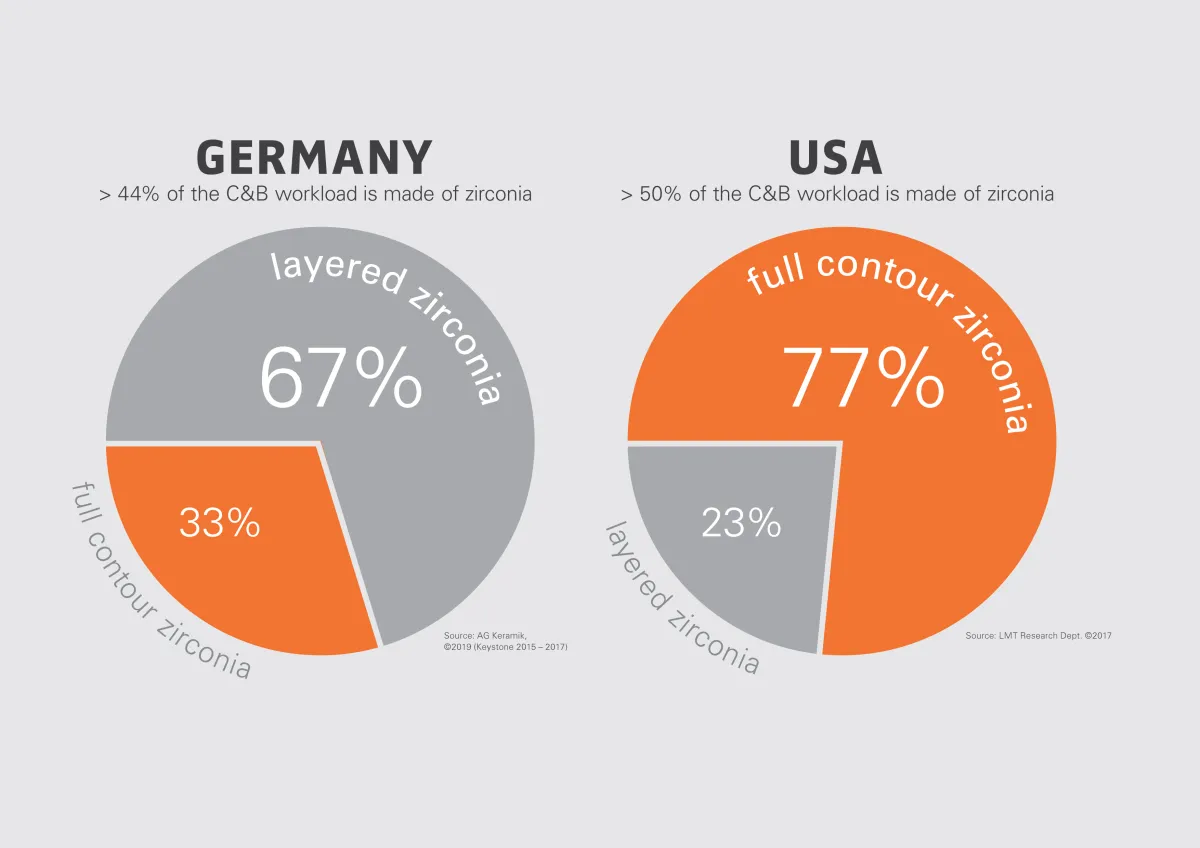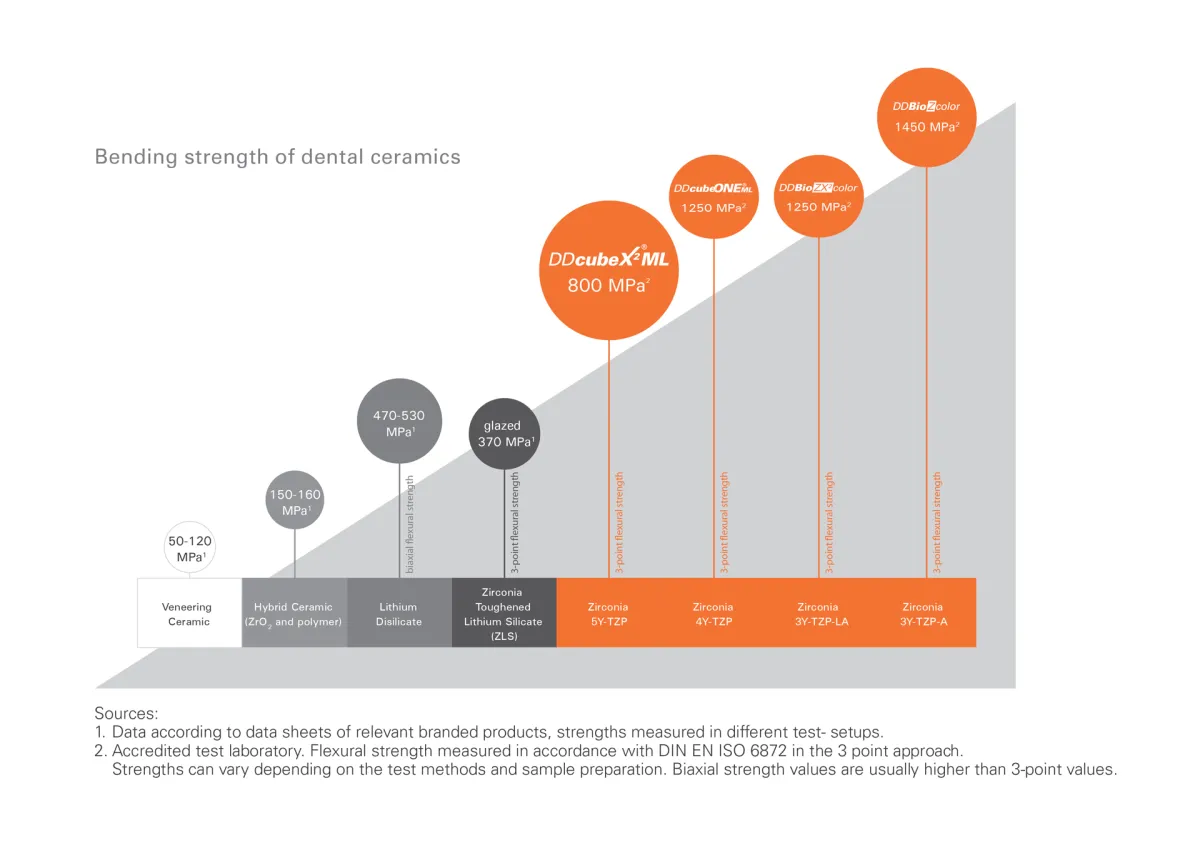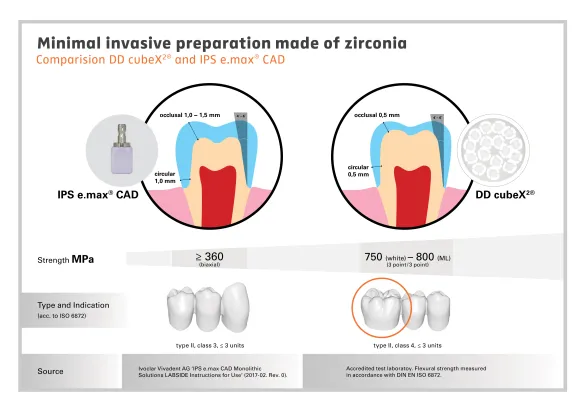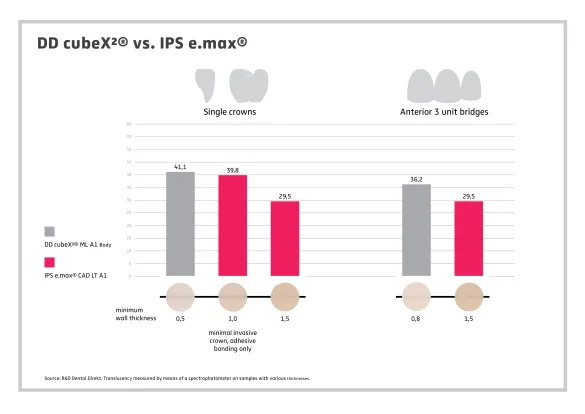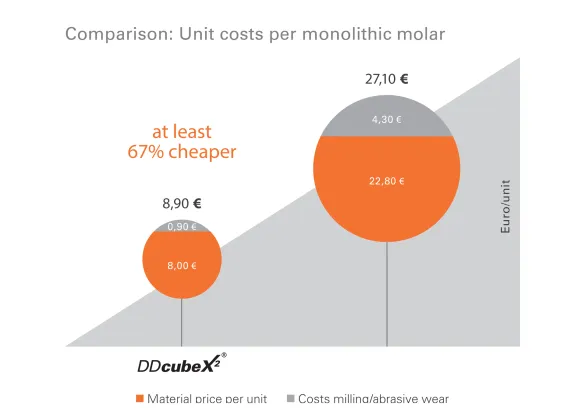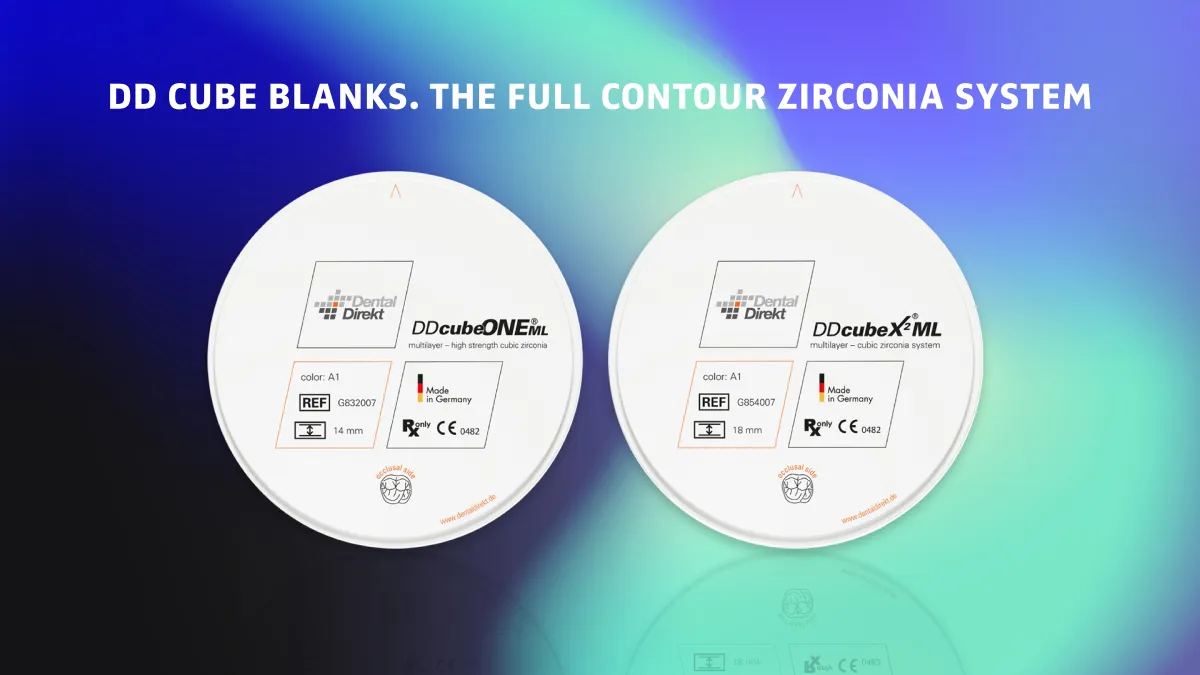DD cubeX²® or 'e.max®'? Zirconium oxide or lithium disilicate?
Zirconium oxide has established itself internationally as a denture material. In particular, more and more full monolithic restorations are being manufactured without ceramic veneering. (Figure 1)
For a long time, the silicate ceramics, in particular lithium disilicate materials, were considered the optimum from an aesthetic point of view.
It is time to review this widespread assumption. We are going to compare DD cubeX²® 5Y TZP zirconium oxide and IPS e.max® CAD lithium disilicate with regard to their mechanical and aesthetic properties and also take a look at economic aspects and suitability for everyday use in the dental technician's laboratory.
Figure 1: Full monolithic restorations – Germany and USA in comparison
The facts: Zirconium oxide is gathering momentum, even in Germany
The latest studies prove:
(see the results of the AG Keramik practical study, in which resident dentists were asked about material preferences and trends: Status Vollkeramik - jetzt im Praxisalltag, Wiesbaden 2019)
The use of oxide ceramics (zirconium oxide, aluminum oxide) for crowns and bridges has increased by 613 percent in the last 15 years. More than half of all dentists surveyed see a growing trend for zirconium oxide ceramics in the future.
The study shows that crowns, partial crowns and inlays in the posterior region have increasingly been made monolithically from zirconium oxide in recent years. And dentists increasingly chose the oxide ceramic alternative for the aesthetically sensitive anterior tooth area as well. In 2017, more veneered zirconium oxide anterior bridges and crowns were used than anterior tooth restorations made of lithium disilicate (Figure 2).
Zirconium oxide is increasingly advancing into the indication domains of the lithium disilicate.
Quality and aesthetics of zirconium oxide are recognized also in Germany
ZrO2 on the rise : 613% increase (2002-2017)*
|
Anterior |
Posterior crowns |
Partial crowns |
Inlays | Anterior bridge |
Posterior bridge |
|||||||
|---|---|---|---|---|---|---|---|---|---|---|---|---|
| 2015 | 2017 | 2015 | 2017 | 2015 | 2017 | 2015 | 2017 | 2015 | 2017 | 2015 | 2017 | |
| Monolithic zirconium oxide |
6% | 6% | 9% | 15% | – | 12% | – | 21% | – | 6% | 7% | 12% |
| Veneered zirconium oxide | 12% | 26% | 26% | 22% | – | 2% | – | 1% | 35% | 37% | 31% | 34% |
|
Lithium disilicate |
26% | 22% | 18% | 16% | 68% | 36% | 22% | 27% | 10% | 10% | 3% |
1% |
Figure 2: Development of zirconium oxide in comparison with lithium disilicate from 2015 - 2017.
* Source: AG Keramik, Status Vollkeramik – Jetzt im Praxisalltag, 2019
Explanation of the facts: Advantages of the DD cubeX²® compared to IPS e.max® CAD
As a manufacturer of zirconia blanks, we see 5Y-TZP zirconium oxide such as the DD cubeX²® as the reason for the increasing trend towards monolithic zirconium oxide constructions, which is no longer limited to restorations in the posterior region. After all, the material of the third generation of zirconium oxide combines high aesthetic translucency with outstanding mechanical properties: as beautiful as lithium disilicate and as stable as zirconium oxide - that is the DD cubeX²®.
1. DD cubeX²® has significantly better mechanical properties than IPS e.max® CAD
DD cubeX²® should not be understood as a replacement for the high-strength 3Y and 4Y-TZP ceramics.
Rather, it offers highly aesthetic solutions that are otherwise only known from glass ceramics
Many years of experience with the first and second generation zirconium oxides show that the strength and fracture toughness of a ceramic material are decisive for its stability and its long-term clinical behavior. DD cubeX²® not only has a significantly higher strength (Figure 3), but with >4.0 MPa√m its fracture toughness is also about twice as high as lithium disilicate with 2.0 MPa√m (source: IPS e.max. Scientific Report, Vol. 03/2001 - 2017).
Due to the better mechanical properties, DD cubeX²® can be used for a wider range of indications. While the manufacture of three-unit bridges for IPS e.max® CAD is limited to the premolar area according to the manufacturer’s specifications (source: Ivoclar Vivadent AG 'IPS e.max CAD Monolithic Solutions LABSIDE Instructions for Use' (2017-02. Rev.0)) DD cubeX²® can also be used to reliably fabricate three-unit molar restorations.
(For more on the subject of fracture toughness see: Greitens, Uwe, Die Relevanz der Bruchzähigkeit als Qualitätskriterium, in: Quintessenz Zahntechnik, 01/20, pp. 96 - 99; or in our DD Journal: https://www.dentaldirekt.de/de/dd-journal/kic-unbekannte-kennzahl).
2. With DD cubeX²®, minimally invasive preparations can be implemented - relativizing the initial translucency advantages of the IPS e.max® CAD
Due to the very good mechanical properties, DD cubeX²® can also be used for minimally invasive preparations. Individual crowns made of cubic zirconium oxide can be designed with wall thicknesses of 0.5mm. For IPS e.max® CAD, on the other hand, the manufacturer recommends minimum wall thicknesses between 1mm and 1.5mm, which requires significantly more substance removal by the practitioner (see Fig. 4).
The wall thickness - regardless of the material - ultimately affects the translucency of a restoration. If the manufacturer's recommended minimum wall thicknesses are included in the translucency comparison of DD cubeX²® and IPS e.max® CAD, the supposed advantage of lithium disilicate is put into perspective. In internal measurements with a minimum wall thickness of around 41%, DD cubeX²® shows a slightly to significantly higher translucency than IPS e.max® CAD LT (see Figure 5: IPS e.max CAD 1.0mm ~ 40% / IPS e.max CAD 1.5mm ~ 30%, source: R&D Dental Direkt. Translucency measured with a spectrophotometer on non-polished samples (as fired) of different thickness,).
The higher initial translucency of the IPS e.max CAD® LT compared to DD cubeX²® loses relevance if restorations with at least double the wall thickness have to be designed.
3. DD cubeX²® is cheaper to process and easier to integrate into the dental technician's everyday laboratory than IPS e.max® CAD
In addition to greater certainty of success due to the mechanical advantages, DD cubeX²® also offers greater economic efficiency compared to other CAD / CAM materials. DD cubeX²® is optimized for machining with the usual, fast zircon milling strategies. In contrast to IPS e.max® CAD, there is no need for wet grinding. This reduces the risk of incorrect work and waste. In particular, the chipping rate in the area around the crown is lower.
| DD cubeX²®:
Calculation: 14 mm disc without discount, benefits: 22 crowns Tools: DD dura mill, 3 mill strategy, assumption of a uniform wear. Service life approx. 100 crowns |
IPS emax® CAD:
Calculation: Material Price e.g. e.max®* CAD for CEREC/inLab, HT, C14, average depo price in Germany. Tools: Service lives are described in different sources from 10 – 25 units, assumption of 20 units, 3 grinder strategy, assumption of a uniform wear. |
Conclusion: From 'e.max®' only the “x” remains, namely in the DD cubeX²®
IPS e.max® CAD has been meeting the highest aesthetic standards for years, but DD cubeX²® at least withstands the visual comparison. It offers clear advantages in terms of mechanical properties and restoration design, which favors preparation that is gentle on the substance. In addition, DD cubeX²® is more economical to process and quicker and easier to integrate into the daily work of the dental technician.
DD cubeX²® is a denture material that combines the strengths of lithium disilicate and the strengths of the zirconium oxide types of the first two generations, making it absolutely the right choice for every dental technician who relies on safety, functionality and aesthetics.
With our DD cube blanks and DD contrast® - color & texture systems, we offer you an all-ceramic material solution for monolithic restorations. For all indications, for every individual patient case.
Note: Material comparison IPS e.max® CAD LT and DD cubeX²®. e.max® is a registered trademark of Ivoclar Vivadent AG, Liechtenstein






